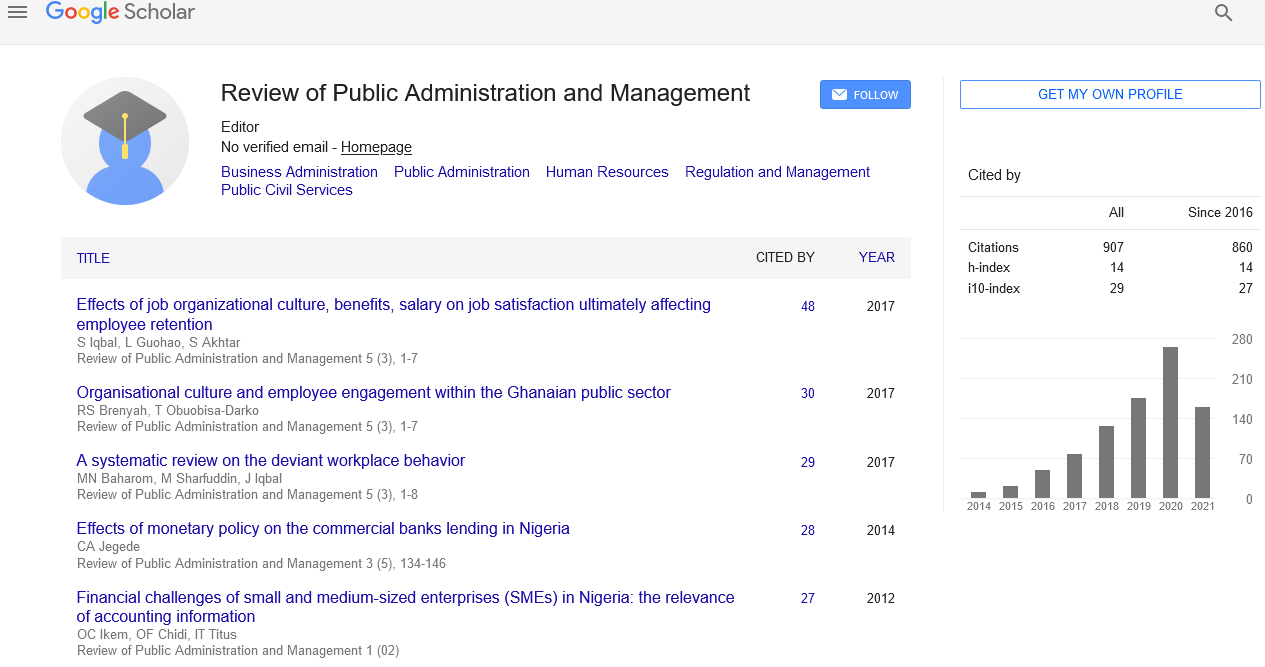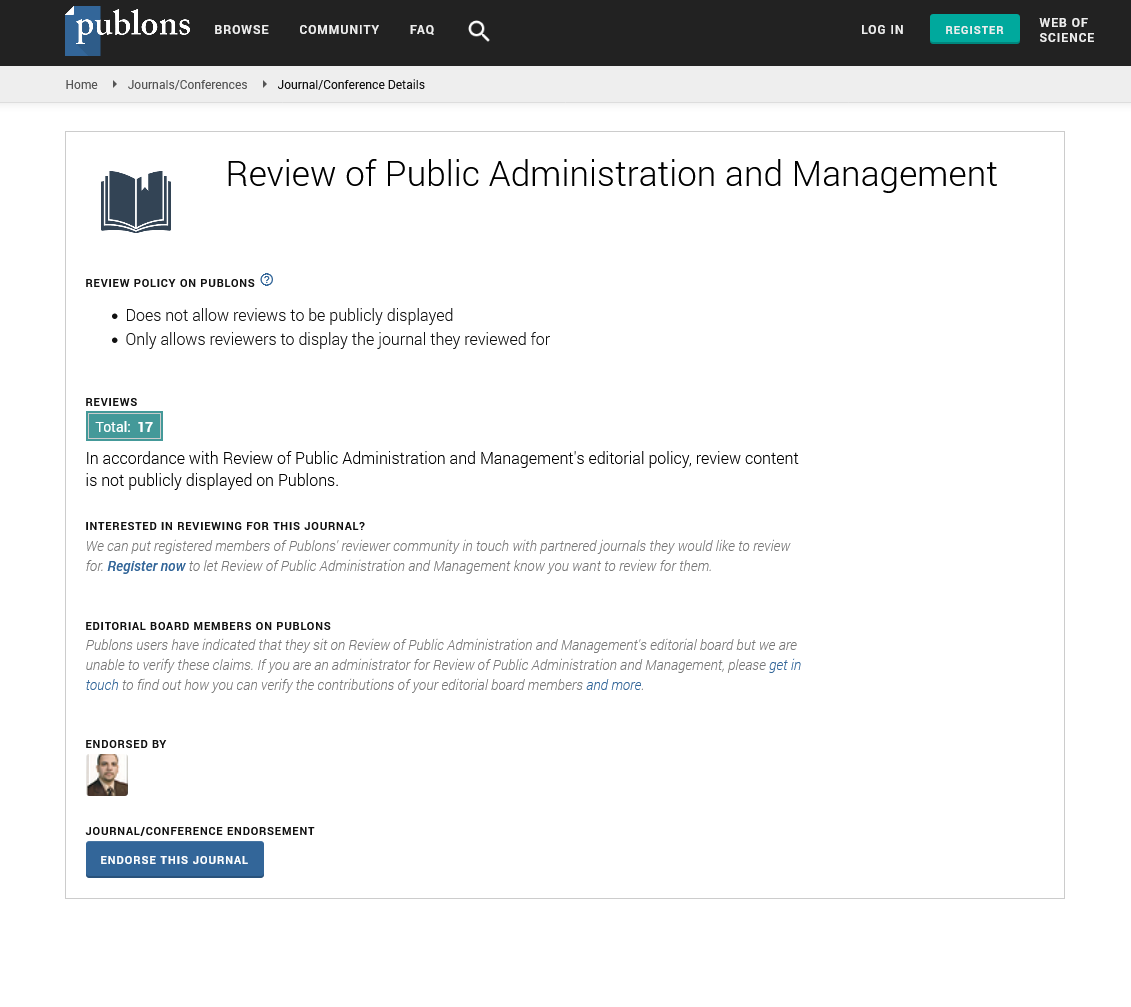Indexed In
- CiteFactor
- RefSeek
- Directory of Research Journal Indexing (DRJI)
- Hamdard University
- EBSCO A-Z
- Scholarsteer
- Publons
- Euro Pub
- Google Scholar
Useful Links
Share This Page
Journal Flyer

Open Access Journals
- Agri and Aquaculture
- Biochemistry
- Bioinformatics & Systems Biology
- Business & Management
- Chemistry
- Clinical Sciences
- Engineering
- Food & Nutrition
- General Science
- Genetics & Molecular Biology
- Immunology & Microbiology
- Medical Sciences
- Neuroscience & Psychology
- Nursing & Health Care
- Pharmaceutical Sciences
Commentary - (2025) Volume 13, Issue 1
Citizen Participation in Policy Making: Trends and Administrative Challenges
Emily Thompson*Received: 24-Feb-2025, Manuscript No. RPAM-25-29218; Editor assigned: 26-Feb-2025, Pre QC No. RPAM-25-29218; Reviewed: 12-Mar-2025, QC No. RPAM-25-29218; Revised: 18-Mar-2025, Manuscript No. RPAM-25-29218; Published: 26-Mar-2025, DOI: 10.35248/2315-7844.25.13.484
Description
Citizen participation in policy making has gained increasing prominence in contemporary public administration as governments strive to become more transparent, inclusive and responsive. The shift toward participatory governance reflects a growing recognition that effective policy outcomes depend not only on expert knowledge and bureaucratic efficiency but also on the experiences, needs and aspirations of the people the policies are meant to serve. In democratic societies, citizen engagement in decision-making processes is seen as a cornerstone of accountable governance, enhancing legitimacy and trust in public institutions. This study explores emerging trends in citizen participation, while also critically examining the administrative challenges that hinder the effective integration of participatory practices in policymaking frameworks.
Over the past two decades, advances in Information and Communication Technologies (ICTs), growing civil society movements and rising public awareness have expanded the avenues for citizen engagement in governance. Traditional forms of participation such as voting, public consultations and town hall meetings are now complemented by more dynamic mechanisms like participatory budgeting, digital platforms for crowdsourcing ideas, online petitions, deliberative forums and social media-based feedback systems. These tools have made it easier for citizens to contribute their voices to policy dialogues, enabling real-time interaction with policymakers and expanding the scope of policy influence beyond formal electoral cycles.
One of the most notable trends is the institutionalization of participatory mechanisms in local governance. In several countries, local governments have adopted structured frameworks for participatory planning and budgeting, allowing citizens to decide how a portion of public funds should be allocated. These initiatives have shown promise in fostering community ownership, improving public spending efficiency and addressing grassroots needs more effectively. Additionally, participatory approaches have been increasingly adopted in environmental policy, urban planning, public health and education reforms, where local knowledge and lived experiences are invaluable in shaping sustainable and inclusive outcomes.
Despite the growing momentum, embedding citizen participation into the policymaking process remains a complex challenge for public administrations. A significant hurdle lies in the bureaucratic culture itself. Many government institutions still operate within top-down, hierarchical models that view public input as a procedural requirement rather than a valuable resource. This mindset often leads to tokenistic participation, where citizens are consulted only to legitimize pre-determined decisions, rather than genuinely influencing policy direction. Changing this organizational culture requires strong political will, institutional reforms and capacity-building among civil servants to facilitate meaningful citizen engagement.
Moreover, issues of representativeness and inclusivity continue to pose critical concerns. Participatory processes often reflect the voices of more organized, educated, or digitally connected groups, while marginalized communities including the poor, rural populations, minorities and persons with disabilities may be left out of the dialogue. This creates a participation gap that can further entrench social inequities and weaken the credibility of participatory mechanisms. To address this, governments must adopt inclusive strategies that ensure equitable access to participatory opportunities, such as outreach programs, offline engagement methods and multilingual platforms that accommodate diverse citizen needs.
Another administrative challenge is the lack of institutional infrastructure and expertise to manage participatory processes effectively. Designing participatory frameworks requires coordination across multiple departments, trained facilitators, resource allocation and systems for collecting, analyzing and incorporating public input into policy documents. Many public institutions lack the tools or trained personnel to do this systematically, leading to fragmented or poorly managed engagement exercises. Additionally, there is often ambiguity about how citizen feedback translates into policy action, which can create frustration and disengagement among participants if their contributions appear to have no tangible impact.
The digitalization of participation has brought both opportunities and new complexities. On one hand, online platforms allow for broader outreach, quicker feedback loops and lower participation costs. On the other hand, they also raise concerns related to digital divides, data privacy, misinformation and cyber manipulation. For instance, reliance on online feedback mechanisms can inadvertently exclude people without internet access or digital literacy, especially in rural or economically disadvantaged areas. Ensuring the security, transparency and credibility of digital participation platforms is essential for building public confidence in these tools and avoiding potential misuse.
Furthermore, managing public expectations is crucial. While participatory mechanisms enhance democratic legitimacy, they also raise expectations for responsiveness and policy change. If citizens perceive that their input is ignored or leads to minimal impact, trust in institutions can erode rather than improve. Therefore, feedback loops where government agencies communicate how citizen input influenced decisions are vital. Transparency in this regard builds accountability and encourages sustained public engagement over time.
International experiences offer valuable lessons. Countries such as Brazil, Canada, Finland and South Korea have pioneered innovative participatory models. Brazil’s participatory budgeting in Porto Alegre has empowered local residents to allocate funds, influencing other cities globally. Canada’s open government strategies promote data transparency and inclusive consultations, while Finland’s crowdsourcing laws platform allows citizens to propose legislative changes. These examples show that with adequate planning, inclusivity and institutional commitment, participatory policy making can be both feasible and impactful.
In conclusion, citizen participation in policy making is not merely a democratic ideal but a practical necessity in today's complex governance environment. It strengthens public trust, enhances policy relevance and fosters civic responsibility. However, to realize its full potential, public administrations must overcome deep-rooted structural and cultural barriers, invest in institutional capacity and design inclusive, transparent and responsive engagement mechanisms. Participation should be treated as a continuous and iterative process, not a one-time consultation. As societies become more connected and diverse, the ability of governments to listen, respond and co-create policies with citizens will define the future of effective and accountable governance.
Citation: Thompson E (2025). Citizen Participation in Policy Making: Trends and Administrative Challenges. Review Pub Administration Manag.13: 484.
Copyright: © 2025 Thompson E. This is an open access article distributed under the terms of the Creative Commons Attribution License, which permits unrestricted use, distribution and reproduction in any medium, provided the original author and source are credited.


